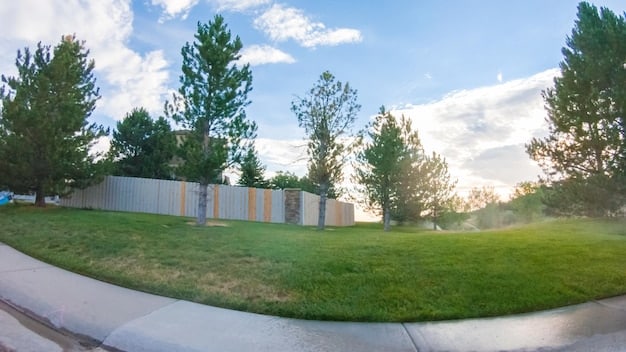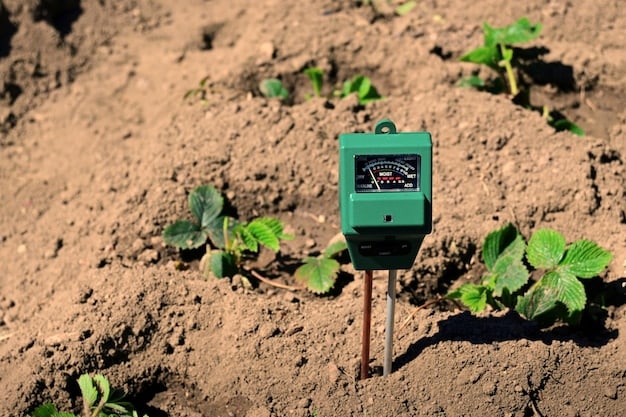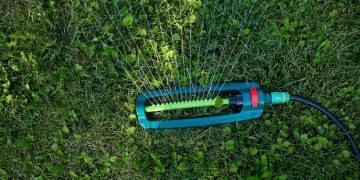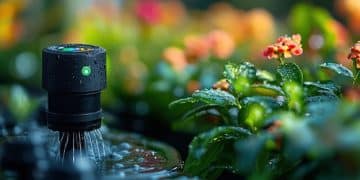Automate Your Garden: Smart Irrigation Systems for a Healthier Lawn

Automate Your Garden, ensuring optimal hydration for your lawn with smart irrigation systems that use sensors and custom schedules to conserve water and promote healthier plant growth.
Imagine a lush, green lawn that thrives without demanding constant attention. Automate Your Garden with smart irrigation systems, offering a modern solution for maintaining a healthy, vibrant landscape effortlessly.
Understanding Smart Irrigation Systems
Smart irrigation systems represent a significant leap forward in lawn care technology, moving beyond traditional timers to provide precise and efficient watering schedules. These systems leverage data and technology to optimize water usage, ensuring your lawn receives the exact amount of moisture it needs, when it needs it.
By understanding the core components and functionalities of smart irrigation, homeowners can achieve a healthier, more sustainable, and visually appealing landscape while conserving water and reducing utility bills.
Key Components of Smart Irrigation
Smart irrigation systems are composed of several interconnected components that work together to deliver targeted and efficient watering. Understanding these components is crucial for effectively managing your lawn’s hydration.
- Smart Controllers: The brain of the system, these controllers use weather data, soil sensors, and user-defined preferences to automatically adjust watering schedules.
- Soil Moisture Sensors: These sensors measure the moisture level in the soil, providing real-time data to the controller to prevent overwatering or underwatering.
- Weather Data Integration: Smart systems tap into local weather forecasts to anticipate rain and adjust watering schedules accordingly, maximizing water conservation.
- Smart Sprinkler Heads: These heads are designed for even water distribution and can be programmed to target specific areas or plant types.

Benefits of Using Smart Irrigation
Investing in a smart irrigation system offers numerous benefits for both your lawn and your wallet. From water conservation to healthier plant growth, these systems are a worthwhile upgrade for any homeowner.
- Water Conservation: By delivering the right amount of water at the right time, smart irrigation systems significantly reduce water waste.
- Cost Savings: Lower water bills are a direct result of efficient water usage, making smart irrigation a cost-effective solution in the long run.
- Healthier Lawn and Plants: Consistent and precise watering promotes stronger root growth and overall plant health.
- Convenience and Time Savings: Automated scheduling eliminates the need for manual watering, freeing up your time for other activities.
In summary, understanding the components and advantages of smart irrigation systems sets the stage for a transformative approach to lawn care, enhancing both the health and sustainability of your outdoor space.
Assessing Your Lawn’s Irrigation Needs
Before diving into the world of smart irrigation, understanding your lawn’s unique needs is crucial. Factors like grass type, soil composition, and local climate play pivotal roles in determining the most effective watering strategies.
By conducting a thorough assessment, you can tailor your smart irrigation system to meet the specific demands of your landscape, optimizing water usage and promoting a healthier, more resilient lawn.
Identifying Your Grass Type
Different grass types have varying water requirements. Knowing which type of grass you have is the first step in creating an effective irrigation plan.
- Warm-Season Grasses: Such as Bermuda, Zoysia, and St. Augustine, these grasses thrive in hot climates and typically require less frequent watering.
- Cool-Season Grasses: Including Kentucky Bluegrass, Fescue, and Ryegrass, these grasses prefer cooler temperatures and often need more frequent irrigation.
Understanding Your Soil Type
Soil type affects how well water is retained and absorbed. Different soil types require different watering approaches to ensure optimal hydration.
Sandy soils drain quickly and require more frequent watering in smaller amounts. Clay soils retain water longer and benefit from less frequent, deeper watering. Loamy soils, a mix of sand, silt, and clay, offer a balance of drainage and retention.
Considering Your Local Climate
Your local climate significantly impacts your lawn’s water needs. Factors such as rainfall patterns, temperature fluctuations, and humidity levels should be considered.
For example, arid climates with low rainfall will require more frequent irrigation than humid climates with regular precipitation. Seasonal changes should also be taken into account, adjusting watering schedules as needed to accommodate varying weather conditions.

In conclusion, assessing your lawn’s specific irrigation needs based on grass type, soil composition, and local climate is essential for creating a tailored and efficient watering plan. This assessment lays the groundwork for optimizing your smart irrigation system and achieving a healthy, thriving lawn.
Choosing the Right Smart Irrigation System
Selecting the right smart irrigation system can be a daunting task. With various options available, it’s essential to understand the different types of systems and their unique features.
By carefully evaluating your specific needs, budget, and technical expertise, you can make an informed decision and invest in a system that will deliver optimal performance and water savings for your lawn.
Types of Smart Irrigation Systems
Smart irrigation systems come in several forms, each with its own set of capabilities and benefits. Understanding these types will help you choose the best fit for your landscape.
- Weather-Based Systems: These systems use real-time weather data to adjust watering schedules automatically, ensuring your lawn receives the right amount of water based on current conditions.
- Soil Moisture Sensor-Based Systems: These systems rely on sensors embedded in the soil to measure moisture levels and trigger watering only when needed, preventing overwatering.
- Hybrid Systems: Combining both weather data and soil moisture sensors, hybrid systems offer the most accurate and adaptive irrigation, providing optimal water management.
Factors to Consider When Choosing a System
Several factors should be considered when selecting a smart irrigation system. These considerations will ensure that the system you choose aligns with your specific needs and preferences.
Consider factors such as the size of your lawn, the types of plants you have, your budget, and your comfort level with technology. Additionally, consider the system’s compatibility with other smart home devices and its ease of installation and maintenance.
Popular Smart Irrigation System Brands
Several reputable brands offer high-quality smart irrigation systems. Researching and comparing different brands will help you find a reliable and effective solution.
Popular brands include Rachio, Rain Bird, and Orbit, each offering a range of systems with varying features and price points. Reading reviews and comparing specifications will help you make an informed decision, selecting a system that meets your needs and budget.
In summary, choosing the right smart irrigation system involves understanding the different types of systems, considering key factors such as lawn size and budget, and researching reputable brands. This thorough approach will ensure you select a system that delivers efficient and effective watering for your lawn.
Installation and Setup
Installing a smart irrigation system can seem intimidating, but with careful planning and the right tools, it can be a straightforward process. Whether you opt for a DIY approach or hire a professional, understanding the installation steps is essential.
By following these best practices, you can ensure that your system is set up correctly and functions optimally, providing efficient and effective irrigation for your lawn.
DIY vs. Professional Installation
Deciding whether to install your smart irrigation system yourself or hire a professional depends on your comfort level with technology and your understanding of plumbing and electrical systems.
DIY installation can save money, but it requires time, effort, and some technical skills. Professional installation ensures the system is set up correctly and can save you time and potential headaches, but it comes at a higher cost.
Step-by-Step Installation Guide
For those opting for DIY installation, follow these steps to ensure a smooth and successful setup. Remember to consult the manufacturer’s instructions for your specific system.
- Plan Your Layout: Determine the placement of sprinkler heads and sensors to ensure optimal coverage.
- Install the Controller: Mount the controller in a convenient location and connect it to a power source.
- Connect Sprinkler Heads: Attach sprinkler heads to the existing irrigation lines, ensuring they are securely connected.
- Install Soil Moisture Sensors: Place sensors in strategic locations to monitor soil moisture levels.
- Program the Controller: Use the system’s interface to set watering schedules and customize settings.
Common Installation Mistakes to Avoid
Avoiding common installation mistakes is crucial for ensuring the longevity and effectiveness of your smart irrigation system. Be aware of these pitfalls and take steps to prevent them.
- Incorrect Sprinkler Head Placement: Ensure sprinkler heads are positioned to provide even coverage and avoid overlapping or dry spots.
- Improper Sensor Placement: Place soil moisture sensors in representative areas of your lawn, away from excessive shade or direct sunlight.
- Ignoring Local Codes and Regulations: Check local codes and regulations regarding irrigation systems to ensure compliance.
In summary, proper installation and setup are critical for maximizing the benefits of your smart irrigation system. Whether you choose DIY or professional installation, following best practices and avoiding common mistakes will ensure your system operates efficiently and effectively.
Programming and Customization
One of the key advantages of smart irrigation systems is their ability to be programmed and customized to meet the specific needs of your lawn. By understanding the system’s settings and features, you can optimize water usage and promote healthier plant growth.
Effective programming and customization are essential for unlocking the full potential of your smart irrigation system and achieving a lush, vibrant landscape.
Understanding the System Interface
Familiarize yourself with the system interface, whether it’s a physical control panel or a mobile app. Understanding the interface will allow you to navigate the system’s settings and features with ease.
Explore the different menus and options, such as setting watering schedules, adjusting sensor sensitivity, and accessing weather data. A clear understanding of the interface will empower you to fine-tune your system for optimal performance.
Setting Watering Schedules
Customizing watering schedules is crucial for delivering the right amount of water at the right time. Create schedules that are tailored to your lawn’s specific needs, taking into account grass type, soil composition, and local climate.
Consider setting different schedules for different zones, adjusting watering frequency and duration based on the unique requirements of each area. Use weather data and soil moisture readings to fine-tune schedules and prevent overwatering or underwatering.
Utilizing Advanced Features
Many smart irrigation systems offer advanced features that can further enhance their performance. Take advantage of these features to optimize water usage and promote healthier plant growth.
- Rain Delay: Use the rain delay feature to automatically suspend watering when rain is expected, preventing water waste.
- Seasonal Adjustments: Adjust watering schedules seasonally to accommodate changing weather conditions and plant needs.
- Zone Customization: Customize watering schedules for individual zones based on their specific requirements, ensuring each area receives the optimal amount of water.
In summary, programming and customizing your smart irrigation system is essential for achieving optimal performance and water savings. By understanding the system interface, setting tailored watering schedules, and utilizing advanced features, you can create a lush, healthy lawn while conserving water and reducing utility bills.
Maintenance and Troubleshooting
Proper maintenance and troubleshooting are crucial for ensuring the longevity and effectiveness of your smart irrigation system. Regular maintenance will prevent minor issues from escalating into costly repairs, while effective troubleshooting will help you resolve problems quickly and efficiently.
By following these best practices, you can keep your system running smoothly and enjoy a healthy, vibrant lawn for years to come.
Regular Maintenance Tasks
Performing regular maintenance tasks is essential for keeping your smart irrigation system in top condition. These tasks will help prevent clogs, leaks, and other common issues.
- Check Sprinkler Heads: Inspect sprinkler heads regularly to ensure they are functioning properly and not clogged or damaged.
- Clean Filters: Clean filters regularly to prevent debris from clogging the system and reducing water pressure.
- Inspect for Leaks: Check for leaks in pipes and connections, repairing any leaks promptly to prevent water waste.
Troubleshooting Common Problems
Even with regular maintenance, problems can still arise. Knowing how to troubleshoot common issues will help you resolve them quickly and efficiently.
Common problems include clogged sprinkler heads, low water pressure, and controller malfunctions. Consult the manufacturer’s manual for troubleshooting tips and follow their recommendations for resolving the issue.
When to Call a Professional
While many problems can be resolved with DIY troubleshooting, some issues require the expertise of a professional. Know when it’s time to call in the experts to avoid further damage to your system.
If you encounter complex electrical issues, significant leaks, or persistent controller malfunctions, it’s best to consult a qualified irrigation technician. Attempting to fix these problems yourself could result in further damage or injury.
| Key Point | Brief Description |
|---|---|
| 💧 Water Conservation | Smart systems minimize water waste through precise scheduling. |
| 🌱 Healthier Plants | Consistent watering promotes stronger root growth and overall plant health. |
| ⏱️ Time Savings | Automated watering frees up your time for other activities. |
| 💰 Cost Efficiency | Reduced water usage leads to lower utility bills and long-term savings. |
FAQ: Smart Irrigation Systems
▼
A smart irrigation system uses sensors and weather data to automatically adjust watering schedules. This ensures the lawn receives the right amount of water based on real-time conditions, optimizing conservation and plant health.
▼
With a smart irrigation system you can typically save up to 50% of water compared to traditional systems. Actual savings depend on usage patterns.
▼
Installation difficulty varies; some systems are DIY-friendly, while others may require professional help due to electrical and plumbing connections. Read the system’s installation guide.
▼
Choose a sensor based on soil type and lawn size. Some include wireless connectivity for remote monitoring. Review and compare specifications to select a right one for you.
▼
Sprinkler filters clear from every 2 to 3 months for clear the system and extend the life of the components. Increase the time when rainfall is rare.
Conclusion
In conclusion, automating your garden with smart irrigation systems offers a multitude of benefits, from water conservation and cost savings to healthier plant growth and increased convenience. By understanding your lawn’s unique needs, choosing the right system, and following best practices for installation, programming, maintenance, and troubleshooting, you can transform your outdoor space into a lush, sustainable oasis.





